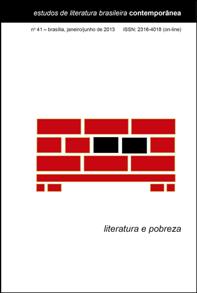Sobre restaurar fios:
reflexões sobre a pobreza em A hora da estrela
DOI:
https://doi.org/10.1590/S2316-40182013000100013Abstract
Este artigo lê o romance A hora da estrela, de Clarice Lispector, sob o fulcro da pobreza. Sob a história da nordestina pobre e fracassada para a vida cola-se uma escrita angustiada e autorreflexiva, metaforizada, no plano da narrativa, no ofício de cerzir, interrompido, e na prática defi ciente de datilógrafa de Macabéa. A pobreza sem enfeites é recurso da autora para colocar em cena sua impotência de escritora.Downloads
References
ARÊAS. Vilma (1997). Con la punta de los dedos. Anthropos, Barcelona, extra 1 e 2, p. 68-72
CANDIDO, Antonio (1993). O discurso e a cidade. São Paulo: Duas Cidades. p. 19-54.
______. ([1979]1987) A nova narrativa. In: A educação pela noite e outros ensaios. São Paulo: Ática. p. 199-215.
GOTLIB, Nádia Batella (1995). Clarice: uma vida que se conta. São Paulo: Ática.
LISPECTOR, Clarice (1984). A hora da estrela. 9. ed. Rio de Janeiro: Nova Fronteira.
OLIVEIRA, S. Ribeiro de (1985). A barata e a crisálida: o romance de Clarice Lispector. Rio de Janeiro: José Olympio; Brasília: INL.
PAES, José Paulo (1999). O pobre diabo no romance brasileiro. In: A aventura literária: ensaios sobre a ficção e ficções. São Paulo: Companhia das Letras.
REZENDE, Beatriz (2008). Contemporâneos: expressão da estética brasileira do século XXI. Rio de Janeiro: Casa da Palavra.
RIBEIRO, Leo Gilson (1977). A hora das estrelas. Jornal da Tarde, São Paulo, p. 19.
RONCADOR, Sônia (2002). Poéticas do empobrecimento: a escrita derradeira de Clarice. São Paulo: Annablume.
SANTOS, Joel Rufino dos (2004). Os pobres. In: Épuras do social: como podem os intelectuais trabalhar com os pobres. São Paulo: Global.
Downloads
Published
How to Cite
Issue
Section
License
Authors who publish in this journal agree to the following terms:
a) The authors maintain the copyright and grant the journal the right of first publication, the work being simultaneously licensed under the Creative Commons Attribution License-Non Commercial 4.0 which allows the sharing of the work with acknowledgment of the authorship of the work and publication this journal.
b) Authors are authorized to enter into additional contracts separately, for non-exclusive distribution of the version of the work published in this journal (eg publish in institutional repository or as a book chapter), with authorship recognition and publication in this journal.
c) Authors are allowed and encouraged to publish and distribute their work online (eg in institutional repositories or on their personal page) after the editorial process, as this can generate productive changes, as well as increase the impact and citation of published work (See The Effect of Free Access).
d) The authors of the approved works authorize the magazine to, after publication, transfer its content for reproduction in content crawlers, virtual libraries and the like.
e) The authors assume that the texts submitted to the publication are of their original creation, being fully responsible for their content in the event of possible opposition by third parties.


